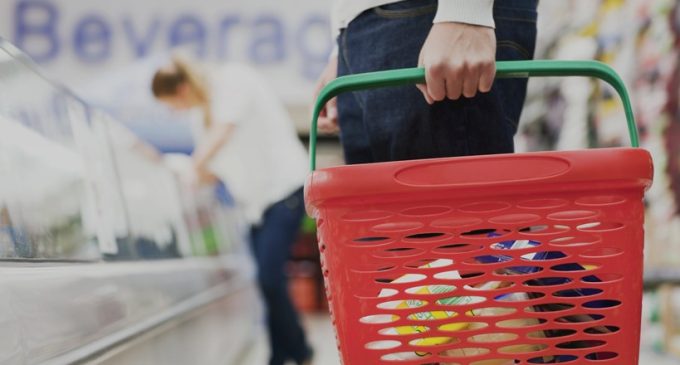Private labels are poised to increase sales as leading FMCG brands pass on inflationary price increases to consumers

Findings from IRI’s biannual ‘FMCG Demand Signals’ report reveals how demand for major supermarkets’ own private labels have dragged, preventing them from capitalising on potential growth in value sales, despite promotions and prominent positioning on grocery apps and websites. However, in this growing inflationary environment, where leading FMCG (fast moving consumer goods) manufacturers are likely to pass on the full impact of price increases to consumers, retailers are poised strategically to hold prices of private labels in categories where they wish to increase penetration and grow value sales.
The report, which covers the year ending July 2021, reveals how national brands throughout Western Europe grew total FMCG value sales by €35bn (an increase of 0.6% YoY) to 67.3% despite private label widening the price gap by almost 100 basis points (BPS), particularly on food and drink prices, by increasing on and offline promotional activity. These offers were withdrawn during the last five weeks of the analysis period on the back of crippling supply-side disruptions and underlying input price increases.
The report also shows that during the pandemic, consumers throughout Europe sought reassurance from buying recognised and trusted brands in almost every FMCG category, despite retailer-owned private labels widening the price gap by offering discounts and promotions.
Ananda Roy, International Senior Vice President, Strategic Growth Insights, IRI, commented: “As the indexed price gap widened between national brands and private labels, you would have expected to see shoppers opting for the substitutes that offered better value. Surprisingly, this didn’t happen. Throughout the major European markets analysed in the Demand Signals study, consumers chose trusted, nationally distributed brands. In response, several retailers offered significant promotions and discounts especially in the period covering Q4 of 2020 and Q1 of 2021 to no avail. In addition, private labels, who often rely on smaller contract manufacturers, were also unable to meet spikes in demand due to lower inventory levels and their own supply-side disruptions.”
Roy continued: “As inflationary measures hit parts of Europe and national brands raise their prices, retailers must decide exactly where they will allow price increases to flow directly through to consumers. Undoubtedly, we will see price hikes for many staple national brands. In categories where major supermarkets and discounters wish to see greater private label penetration, they may decide to hold back and offer more affordable prices.”
The private label categories most likely to see these trends are impulse categories such as chocolate, especially in seasonal gift packs; ambient foods and pre-packed meals, alternative breakfast or light meal ‘better for you’ cereals, grain bars and protein-rich functional foods and drinks, and at-home cooking sauces, condiments and kits.
 IRI’s data scientist teams study billions of FMCG transactions from across the US and several of the largest European and Asia Pacific markets (France, Italy, Germany, Spain, UK, Netherlands and Greece) to understand how consumer demand has shaped category values across more than 230 different food and non-food segments, and to provide clarity on what drives commercial value.
IRI’s data scientist teams study billions of FMCG transactions from across the US and several of the largest European and Asia Pacific markets (France, Italy, Germany, Spain, UK, Netherlands and Greece) to understand how consumer demand has shaped category values across more than 230 different food and non-food segments, and to provide clarity on what drives commercial value.
FMCG overview and category insights from the Demand Signals study
Overall, FMCG value sales grew +3.1%[1] year-on-year to €579bn, with chilled & fresh and ambient food accounting for more than half of all sales (51.3%).
During a period, which covers two significant stay-at-home lockdowns across key European markets, the structure of food-vs-non-food contribution did not change significantly, with food making up on average 80% to 85% of category value. However, the retail channel split did reflect how we bought more food at supermarkets, hypermarkets and discounters.
With the easing of mobility restrictions during the second quarter of this year, online sales declined marginally from highs just above 8% to around 7.5% of overall category value – somewhat more resilient than analysts had predicted as hybrid purchase behaviour seeking ‘deals’ and convenience continue.
It remains to be seen whether the meteoric rise of grocery-delivery services and apps will continue as food prices rise, already wafer-thin retailer margins are eroded, more delivery services become chargeable and online promotions continue to be withdrawn in the second half of this year.
The opening of leisure venues such as restaurants and cafés coinciding with the beginning of the spring and summer holidays, predictably saw alcohol value sales rise +8% YoY (€69.4bn), well over the total FMCG category (3.1% YoY).
Key highlights:
- UK leads growth in wine sales – In the UK, wine increased by €803 million[2], with sales in Germany (€139 million) and Greece (€19 million) also rising. Specialty beers grew to €279 million in France with beers and craft beers impacting growth in Italy (€203 million), Spain (€186 million) and Netherlands (€83 million).
- Shoppers opted for fresh and healthy – Chilled and fresh foods grew 3.4%, largely due to demand for cheese (Germany, €426 million and Spain, €67 million), fresh packaged fish (UK, €214 million) and smoked fish (France, €198 million, up 25%) and chilled meats (Italy, €218 million). But with consumers still working from home, chilled sandwiches (UK, down €217 million) and soft pasta (France, down €50 million) and margarines witnessed continuing declines.
- No freeze on frozen – Frozen foods was the joint-second fastest-growing category in FMCG at 4.4% along with drinks. This was driven by frozen fish and meat and ice-cream (From €45 million in France, €44 million in Spain and €17million in Italy respectively) at the start of seasonal highs in late spring and an unseasonably warm early summer. The casualties were frozen pizzas, vegetables and herbs across markets.
- A healthy thirst – Functional food and drinks are a new trend that continues to grow. We are seeking ‘better for me’ sports and energy drinks. Growth was led by Italy, France and Germany. The category already commands €155 million in the UK which grew 9%. Coffee in all its forms, (beans, pods, single-serve cups, specialty drinks) delivered the highest category value of around €500 million.
- Mixed picture for non-food – The huge rise in sales of gardening tools, supplements, DIY and home-improvement items did not offset the significant decline across personal and household care categories; notwithstanding panic buying of toilet paper, face tissues and anti-bacterial wipes.
- Health and hygiene first – Household products, including carpet cleaners, aromatic oils, cleaning products and disinfectants rose in sales. All forms of cleaning products made up €150 million across the UK, France and Spain.
- Cosmetics fail to cover up decline in non-food – Personal care produced interesting results as the demand for personal hygiene products declined as we continued to work from home and an air of informality influenced consumer choices. Cosmetics and lip makeup in France were down by €65 million; deodorants and body sprays in Germany and the Netherlands dropped by around €45 million, and hairspray and colourants in Italy dropped by €13 million.
- Masks and medicines – The extensive use of face masks, hand sanitisers and cleaners meant we had fewer coughs, colds and allergies, wiping out €165 million in the UK alone from the purchase of de-congestants and anti-allergens.
- Restful retailing – As staying healthy remained a priority for many shoppers, sales of pharmacy and healthcare accessories increased. Aromatherapy, aromatic oils and candles that help facilitate lower stress levels and improve sleep, delivered €200 million across UK, Italy and France.
- US FMCG returns to growth – Manufacturers aggressively reduced stock levels during the first half of 2021, particularly in food and drink, with pricing, promotions and range optimisation. In the five weeks leading to the end of June, fewer promotions, and price points for private label only slightly lower than national brands, enabled total FMCG value share to return to growth (+2.3%).
Footnotes
- Total FMCG Europe (France, Italy, Germany, Spain, UK, Netherlands and Greece) €MAT value sales and YoY% change
- Highest absolute €MAT value growth segments




























